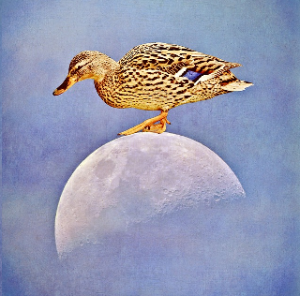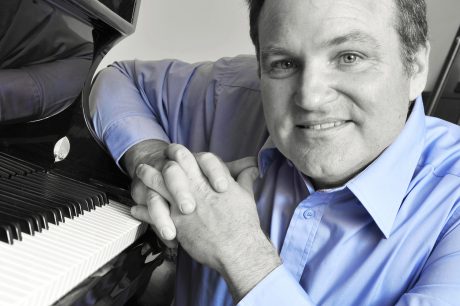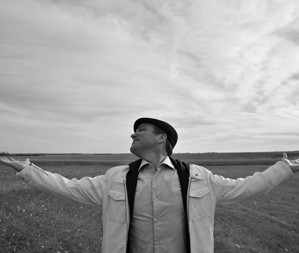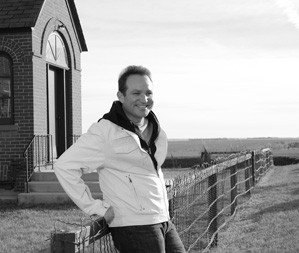Ducks on the Moon
Kelley Jo Burke and Scott Anthony Andrews present
Our Arts-Based Educational Research (ABER) musical project
Magazine “Education News” featuring “Ducks on the Moon: A Play with Music”
Great article about writing the music 4 the Arts-Based Educational Research project “Ducks on the Moon” as featured in “Education News” with Kelley Jo Burke (KJB) and I. Thanks so much Shuana Niessen for the article and the pics! Parts of this ABER were performed at the national Congress for the Social Sciences and Education (CSSE) in May 2018 at the University of Regina, and at the European Congress of the International Scientific Study of Intellectual and Developmental Disability (IASSIDD) in Athens, Greece (July 2018).
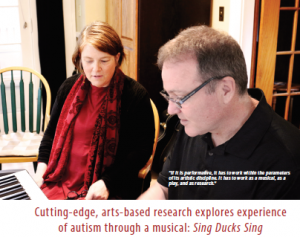 Magazine “Education News” feat “Ducks on the Moon: A Play with Music”
Magazine “Education News” feat “Ducks on the Moon: A Play with Music”
Video Excerpts from draft performance of “Ducks on the Moon-A Play with Music”
All videos by Crushed Rockets (Sherona & Arron Sinclair)
All is Calm For Now…the first song, the audience gets introduced to Noah, KJB’s son
Not Necessarily Me (Was that a Clue?) A salient theme running through the play is: various clues, in various ways, at various times, which point clearly to a diagnosis of ASD. The self-questioning lyric “was that a clue?” speaks to the persistent inner dialogue that the protagonist has with herself, and at least constituents an acknowledgement of her inner suspicions and ASD….though these are dismissed. In the play with music, this song is often reprised to signal another clue.
Guess I Missed those Cumulonimbus Clouds (Wendy the Weather Girl) The very first meeting in which Kelley Jo and I discussed transforming her successful play into a musical, she expressed her strong desire to somehow portray autism—almost as a living entity outside of her son. I must confess this was quite a challenge. After much discussion, we settled on ASD as highly and frequently changeable weather system. This seemed appropriate as many students with ASD are fascinated by the Weather Network with all the numbers, graphs, maps, etc. And at the heart of these systems is Wendy, the Weather Girl, who seems to deny their presence. Guess, she missed those cumulonimbus clouds, she ponders…. Oh oh; Oh, oh….Oh, oh.
So Lovely, So Short-Lived (The Hawaii Story) Kelley Jo performs this most emotional scene, in which the irrepressible desire to have/be a “normal” family, to do “normal” family things, to go on “normal” family vacations, seems to get the better of the protagonist.
“I Don’t Know Anymore (What It Means to be Mum)” At the very heart of the play “Ducks on the Moon”, the protagonist has to come to a new understanding of motherhood—perhaps not a new understanding per se, but a view of parenthood that is likely different than one that she grew up with. The “Welcome to Holland” phenomena; this song captures the struggle of letting go of what one thought parenthood was.
“It Ain’t No Thang (No No)” captures both the protagonist’s limits of what acceptable diagnoses are… spirited child, highly energetic child, hyper-focused on the one hand, and the kind of diagnosis dance that is not uncommon at the beginning stages of navigating the diagnostic world…Attention Deficit Hyperactivity Disorder (ADHD), Oppositional Defiance Disorder (ODD), Generalized Anxiety Disorder (GAD)….etc., on the other hand.
Just Take Your Bow (And He Takes a Bow Story) In talking about the closing piece, Kelley Jo suggested that the musical needed a stronger finale than we had. We thought about how to do so. Eventually, we were reminded of a story that she shared in her Ted Talk about “Ducks on the Moon” in which her son comes right up on stage during one of her performances…and scolds her—after which he takes a bow, and he takes a bow, and he takes a bow. Naturally, I wrote the song “Just Take Your Bow” for our closing number. I decided to include a little excerpt at the beginning of this video in which Kelley Jo shares the takes-a-bow story in her Ted Talk.
Online Blog documenting our journey….
Six Songs Made it to a Complete First Draft…Sing Ducks Sing on the Moon
September 6, 2017.
I recently completed a Songwriting Specialist Certificate from Berklee Online; songwriting is a learned craft. I believe that; I have learned much about songwriting. At the same time, I believe that there is something unique within each of this—and that our uniqueness informs our songwriting. So, learning is not the whole story. Perhaps part of songwriting is ephemeral lying within each of us, and our songs—at least partly—emerge. In my case, I am constantly surprised by the amount of comments about the theatrical quality of my songs—some listeners insist that I have already written for the musical theatre. I have not. And, frankly, it has never been my intent as a songwriter. (Full disclosure: I am writing this entry while listening to “Waving through a Window” from “Dear Evan Hansen.”)
You see, writing a musical is surely very, very difficult. It must be more than “theatrical” or dramatic: songs must move the plot, songs must move the audience, and songs must revere, connect and contrast their musical past. In many ways I cannot imagine writing a musical. Despite the uncomfortable realities of what it means to write a musical, I have attempted one. Justin Gray, a world-class producer, gave me a helpful piece of advice: perhaps I should move in the direction—unbeknownst to myself—in which I seem to be pointing. It may be worth a try.
If you have been following my blog, you know that I have done some reading about writing a musical. You know that, despite everything, I am attempting to write one with Kelley Jo Burke –an adaptation/translation/transformation of “Ducks on the Moon” (2010). Well, I am happy to report that I have the six songs drafted—only drafted, mind you, but still they are completed. Here are the tentative songs:
1. “Not Necessarily Me (Was that a Clue?)”
-Some of these lyrics come pretty closely from the play (see Burker, 2010, p. 56).
2. “All Is Calm Now”
-Lullaby song in 6/8 an a minor key
-This song uses the calming down technique many parents use for their children with ASD to encourage deep breathing by imagining blowing out birthday cake candles
3. “So Lovely, So Short-Lived”
-Reflective song, kind of haunting melody
-This song tries to capture the moments where the protagonist feels empowered, though such moments are sometimes fleeting before official diagnosis and education occur around ASD.
4. “It Ain’t No Thang”
-A blues song about the complexity of labels and diagnoses, such as ASD.
5. “Guess I Missed Those Cumulonimbus Clouds (Wendy the Weather Girl)”
-The “I Am” song that sets up or describes conflict
-Used much weather jargon
6. “I Don’t Know Anymore”
-I think a powerful song, where the protagonist calls many things into question
I am soon to meet with Kelley Jo… I am admittedly nervous…..
Quack Song 2: Game of Clue
February 7, 2017
The second song I’m working on for Sing Ducks Sing, I am tentatively calling Game of Clue. Some parents who have children with Autism Spectrum Disorder report that—in retrospect—there were signs along the way. I guess this may be the case for many things—hindsight may be remarkably and uncomfortably accurate. There is a rather famous poem entitled, Welcome to Holland, in which the protagonist (a parent) must learn to accept a trip to Holland rather than Italy (see http://dsnetworkaz.org/holland/).
It is a letting go of expectations that one may have had, and embracing the realities of what is—of having a child with ASD. Further, it is a call for a celebration of what is—not just acceptance. In this song, the idea is to try to capture some of the typical second thoughts, or brief entertainments of possible ASD diagnosis that Burke may have had about her child. I considered especially the scene on p. 56 of the pay, Ducks on the Moon (2010). …here are the lyrics, so far
GAME OF CLUE
Words & Music: Scott Anthony Andrews (with nods to Kelley Jo Burke see p. 56 of Ducks on the Moon)
VERSE
Asleep in my arms
He looked like any other child
With his eyes closed
He looked like anyone’s son
But when he opened his eyes
He wasn’t looking for my face
A man overboard
Clawing through stormy seas
Looking for something, anything to hold to
Not necessarily me
CHORUS
Was that a clue?
On Sunday morning?
Was that a clue?
Deep in the heart.
Was that a clue?
On Sunday morning?
Was that a clue?
Deep in the heart.
Quack Song 1
Wendy the Weather Girl (Guess I Missed Those Cumulonimbus Clouds)
January 28, 2017
OK. I have my Song Plot for the musical I am co-writing with Burke, Sing Ducks Sing, an adaptation of her one-person play “Ducks on the Moon” (2010). I thought I might start with the I Want Song/Metaphor Song; I did. Tentatively, and I use that word most decidedly, it is entitled, “Wendy the Weather Girl”. The idea that Kelley Jo Burke and I had was to represent the presence of autism (ASD) through something like the weather network. Typically think concretely and visually; perhaps that accounts for why I have come across so many students with ASD that enjoy the weather network. Further, we can expand on weather systems as allegories for ASD. Here’s my first attempt, although I have misgivings about an allegorical song for the “I Want Song.” As it stands the verse is in F major and is the voice of Wendy; the Chorus is based upon the F blues scale for contrast. It is hopefully obvious that this latter section is indicative of various nomenclatures one associates with weather. The crux of the song is that Wendy misses the obvious in her forecast, her invisible gorilla, is cumulonimbus clouds–
Nevertheless, see the lyrics below
VERSE
I’m Wendy the weather girl
A forecast of smiles for you (oh, oh, oh oh)
Wendy the weather girl
Calling for a shower or two (oh, oh, oh oh)
Gusty with a little sprinkle
Just enough to fluff your hair
I’m Wendy the weather girl
Tune in for temperatures true
CHORUS
Guess I missed those cumulonimbus clouds
Seen at 2 pm, 5 kms Northwest,
Tracking east, digging in like a thunder clap
Gaining speed, spinning fast, anemometers snap
Skies of grey, 80K , what you say ‘bout that?
Guess I missed those cumulonimbus clouds
My First Quack at It
An Initial Song Plot: Sing Ducks Sing
February 2, 2017.
I re-read Burke’s play, Ducks on the Moon (2010) last night; I will likely continue to do so, as I continue to work on our Art-Based Educational Research project. Ducks is a one-woman 90 minute play; it seems reasonable to keep it a one-woman show, so I am looking at possibly 4-5 songs. Mandelbaum’ s caution resonates: avoid a “ ‘chop and drop’ job, with the original play cut down to make way for the [songs] (1991 p. 178). And at the same time, Frankel (2000, p. 22) reminds me that “songs take over most of the main points of the plot.” So I must ask myself:
What is the central struggle in this drama, the central I Want?, and is there anything missing from this struggle that songs might add? And still in this context, what is missing particularly in the high points. Burke’s struggles with how to cope with a child that is decidedly different than her other children. She is an experienced and knowledgeable parent:
“I’m not ecstatic and I’m not scared. He’s my third child, and I know how to feed him, and I know how to wash him, and I know exactly where to put him in the crook of my arm. I am an old mum, and I am up to anything he’s got” (Burke, 2010, p. 28).
What needs to come across I think in terms of the musical is the struggle to accept the autism diagnosis, and to accept certainly, but more importantly, is the struggle for the protagonist to accept help in raising her son; the protagonist comes to understand that she cannot do it all—that there are reasonable limits (even) to her parenting. This lesson is a hard-fought high-point:
Down on the floor. Curled into the fetal position, keening like to an Amazonian monkey, in a shrill counterpoint to the bass thrum of the rental car outside chugging through its tank of very expensive America gas—just shriek and shriek and shrieking that I couldn’t do this, I couldn’t plan this, I couldn’t make it right, I need help, I need help, I need help, I need help, I need help… (Burke, 2010, p. 50)
Acceptance then are is the big I Want and I Am messages of this musical. In terms of the layers of educational import; obviously this play is particularly useful for understating parent/professional relationships in the context of students with ASD—not the least of which may be how parental self-efficacy may be impacted, perhaps particularly if the child is not first-born. Given these contingencies, here is my initial song plot:
A Rubber Duck Chorus Line…
Initial Song Plot…
- A breathing calming song; a blowing out the birthday cake candles song. An implied duet. A breathy, small and simple song.
- I Want Song/Metaphor Song. What may be missing from the current play is a portrayal of how ASD may present, of what ASD is, in real time, not a recollection—more specifically here, a depiction of the real-time struggle, of a parent wrestling with a son with (for most of the play undiagnosed) ASD in an attempt to plan for and control the un/known. This may be going out on a limb, but Kelley Jo Burke and I have discussed using something akin to the Weather Network as a metaphor for ASD; in ways this is apt since many people with ASD appreciate all the numbers inherent in today’s weather forecasts; including temperature, degrees, wind chill values, wind speed and direction, precipitation accumulations and kinds, UV index, 5-day forecasts, historical daily high and low temperatures, etc.However, I must remember that this is a play about Burke’s struggle. So, if using a weather network kind of metaphor, perhaps casting the protagonist as a live meteorologist who makes forecasts that are completely inaccurate. She could be reporting from the field…something like “called for a 1.5 cms of snow and I am here in 60km/h blizzard”. “Wendy the weather girl” Possibly.
- Diagnosis Dance ~or~ Diagnosis on Ice. This could introduce movement into the piece; for some reason I am leaning to the concept of ice-dancing or figure-skating as opposed to ballroom dancing. In my brain I think of ice-dancing as being weather-related, though I have no reason why to make such an association. This could be an upbeat song, like a tent pole song, although it comes early in the play.
- Clue: The Song of Clue. Burke discusses throughout her play the many clues that became obvious in retrospect, as may often be the case in situations such as these. This could be another comment/metaphor song. It may be possible to keep a similar form as the one many are familiar with, as…. “Colonel Mustard did it in the Conservatory with the revolver.” I am thinking that this may be quite similar to the Diagnosis Dance; however, unless I take steps to prevent this.
- Finally, several times in the play, Burke (2010) says “This is the last time I will feel this way for the rest of my life…” (p. 28). There is a lament there; at the same time, there is possibility; there is future. My feeling is that this could be an effective song; if done correctly, it could capture the myriad emotions that thread through the play. It would be conceivable to draw upon images of things that Burke did as a parent with her other children—things that were not as successful for Noah.
And that, Ladies and Gentlemen is my first go round of a Song Plot for “Sing Ducks Sing” ….stay tuned for the first song draft….
References
Burke, K.J. (2010). Ducks on the Moon: A Parent Meets Autism. Hagios Press: Regina, SK.
Frankel, Aaron (2000). Writing the Broadway Musical (Revised and Updated). USA: Da Capo Press.
Mandelbaum, Ken (1991). Not Since Carrie: Forty Years of Broadway Musical Flops. New York: St. Martin’s Press.
Quack Song 1
Wendy the Weather Girl (Guess I Missed Those Cumulonimbus Clouds)
January 28, 2017
OK. I have my Song Plot for the musical I am co-writing with Burke, Sing Ducks Sing, an adaptation of her one-person play “Ducks on the Moon” (2010). I thought I might start with the I Want Song/Metaphor Song; I did. Tentatively, and I use that word most decidedly, it is entitled, “Wendy the Weather Girl”. The idea that Kelley Jo Burke and I had was to represent the presence of autism (ASD) through something like the weather network. Typically think concretely and visually; perhaps that accounts for why I have come across so many students with ASD that enjoy the weather network. Further, we can expand on weather systems as allegories for ASD. Here’s my first attempt, although I have misgivings about an allegorical song for the “I Want Song.” As it stands the verse is in F major and is the voice of Wendy; the Chorus is based upon the F blues scale for contrast. It is hopefully obvious that this latter section is indicative of various nomenclatures one associates with weather. The crux of the song is that Wendy misses the obvious in her forecast, her invisible gorilla, is cumulonimbus clouds–
Nevertheless, see the lyrics below
VERSE
I’m Wendy the weather girl
A forecast of smiles for you (oh, oh, oh oh)
Wendy the weather girl
Calling for a shower or two (oh, oh, oh oh)
Gusty with a little sprinkle
Just enough to fluff your hair
I’m Wendy the weather girl
Tune in for temperatures true
CHORUS
Guess I missed those cumulonimbus clouds
Seen at 2 pm, 5 kms Northwest,
Tracking east, digging in like a thunder clap
Gaining speed, spinning fast, anemometers snap
Skies of grey, 80K , what you say ‘bout that?
Guess I missed those cumulonimbus clouds
A Quacking Song Plot
January 10, 2017
Quacker-Three
Welcome friends to my online blog about my Arts-Based Educational Research (ABER) project, where I am adapting Burke’s play, Ducks on the Moon (2010) into a musical. Some may call this project quackery, but I am already on my third posting, so I am calling this posting quacker-three. In the second posting, I highlighted the different kinds/ways of incorporating music into plays (play-with-music and musical drama) and the different types of musical theatre songs (I Am Song, I Want Song, Comment Song, Metaphor Song, Opening Number, Reprise and Segue, and finally Tent Pole Song). Today, I consider a few guidelines about lyric writing, musical theatre songwriting more generally, and the placement of songs within the musical, or what is sometimes referred to as the Song Plot.
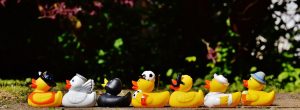 About lyrics…
About lyrics…
Writing musical theatre lyrics may be different than writing for smooth jazz or pop songs, but they are some similarities. One truism salient to both genres seems to be: show, don’t tell; or, stated differently “Calling next on the senses will translate abstractions into concreteness. Metaphors, neologisms—whatever hits the fancy, no pondering or editing. Seize.” (Frankel 2000; p. 30). In other words, good lyrics must taste as such; as opposed to be understood as such.
About musical theatre songwriting…
The biggest lesson for me about musical theatre and smooth jazz/pop songwriting is probably THE crucial difference between them: in the theatre songs must have narrative motion; they journey; they ambulate; they arrive. Certainly pop songs may do as well, though it does not appear to be imperative. Indeed, Viertel (2016) recalls “perhaps the greatest example of Hammerstein’s dictum that a song should be a miniature play, with its own movement, conflict and resolution” (p. 64).
About the Song Plot…
From my understanding, a song plot is all the songs in a musical without any dialogue. A songs-only chart allows the writers to examine how the musical narrative flows through music; ideally, one strives for variety and placement: “Musical synopsis shows whether the number is the right one, and in the right place. This includes the alteration of numbers—among the different characters, between solo and group numbers, and among kinds of numbers (ballads, rhythm tunes, special material and production numbers” (Frankel 2000; p. 65). So, the writer should manage dramatic tension through the songs; and one way to do so is to “var[y] rhythmic impulses or charges. High or low, the rhythmic contrast between these charges is what makes them effective” (Frankel 2000; p. 32).
And, of course there are not only rhythmic contrasts, since “the complement of rhythmic contrasts is visual variety. Musical theatre moves figures through mere signals of place, on an open platform of space, and keeps the space free for change; this makes all musicals spectacles” (Frankel 2000; p. 33). And, again the Viertel (2016) suggests that variety is the goal, for “as soon as the audience understood a visual idea and taken pleasure from it, another idea has to be presented. As soon as the sound of a trio has been enjoyed, the quartet has to enter, then the octet, then the entire company” (p. 110).
Conclusions…
So, my next task is to re-read Ducks on the Moon, look for those dramatic high points and create a tentative song plot
References
Burke, K.J. (2010). Ducks on the Moon: A Parent Meets Autism. Hagios Press: Regina, SK.
Frankel, Aaron (2000). Writing the Broadway Musical (Revised and Updated). USA: Da Capo Press.
Viertel, Jack. (2016). The Secret Life of the America Musical: How Broadway Shows are Built. New York: Sarah Crighton Books.
A Musical Needs to Quack Like One
Sing Ducks Sing: Quack 2
by Scott Anthony Andrews
So, I began with a great idea of conducting Arts-Based Educational Research (ABER) by adapting Burke’s play, Ducks on the Moon (2010) into a musical. What I find daunting is that arts-based research is ARTS-based, and in our project, it is the musical form that is at stake. Although I have released two CDs of original music, Faith is a Bicycle (2013), Courage Walks with Us (2014), and am soon to release a third CD later this year, tentatively titled, I Don’t Do Lazy Like That; these are smooth jazz/pop songs. These are not musical theatre songs. Although ABER is form(s) of educational research, it operates within particular artistic forms with their own traditions. My first task then is to gain at least a rudimentary understanding of the breadth of the musical theatre landscape, and how to write one. To that end I read six books (Atkey, 2006; Frankel, 2000; Kniffel, 2013; Mandelbaum, 1991; Mordden, 2013; Viertel, 2016), and consulted two online resources (Brown, 2007; Miles, 2014).
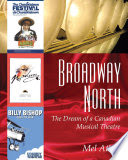 From these readings, there appear two over-arching (and inter-related) distinctions that appear useful as I begin the composition phase:
From these readings, there appear two over-arching (and inter-related) distinctions that appear useful as I begin the composition phase:
- What are the kinds of musical plays? …Or, asked differently, how might music be incorporated into and/or transform a play?
- What are the kinds of songs within musical theatre?
The following section will wrestle with these questions. At the end of each section, I focus my thinking in light of Sing Duck Sing.
Play-with-Music or Musical Drama?
There is significant variation in the musical form(s) itself, including: play-with-music, musical comedy, musical drama, revue, Broadway opera, musical revue, operetta (Frankel 2000; p. 16). There are some effective and popular plays-with-music, such as “George Ryga and Ann Mortifee’s… The Ecstasy of Rita Joe in 1973” (Atkey, 2006, p. 16), though currently there seems to be more musical comedies and musical dramas that are successful. Music operates differently within these formats—particularly so between plays-with-music and musical dramas:
“Between a show song and a pop song, however there is a basic difference. The former is a dramatic action, the latter is not. A show song is a heightened action springing from a dramatic context, and as a results reveals character, develops situation, forwards plot. It lands somewhere else from where it started, it makes a difference” (Frankel 2000; p. 90).
A play-with-music may have songs tangentially related to the dramatic action—almost evocative of the theme; whereas, musical dramas tend to have songs that are ideally constitutive of the plot. Characters sing their lines. Indeed, Frankel (2000, p. 22) claims that “songs take over most of the main points of the plot, and makes them the high points.” In fact, he suggests that “songs heighten action more than dialogue” (p. 22). Ideally, then one must choose a book/play to be musicalized in which “something is at stake” (Viertel 2016, p. 18), and contains “actions high enough to break into songs” (Frankel 2000; p. 22).
My Duck asks: Look for the high points in the play…see how they may be enhanced, while being mindful of the “ ‘chop and drop’ job, with the original play cut down to make way for [the songs]” (Mandelbaum, 1991, p. 178). This, if Sing Ducks Sing will be a musical drama; otherwise consider a play-with-music.
Musical Theatre Song Types
Songs for the theatre may be written within many different genres or styles, but there are some specific song types for the musical theatre—some of which seem to be defined by character and plot development; others, seem defined by placement within the musical. Having said that however; it appears that these categorical types are used out of routine, since action/plot reveals character. As in pop songwriting it is better to show not tell; and in musical theatre, it is better to show character through deeds, trials or activities rather than description.
Opening Number
Obviously one of the first songs, it can “introduce a hero or heroine whose burning passion would drive the plot” (Viertel 2016, p. 22). How to start a musical seems not an easy question; Frankel, 2000 (p. 111), ponders that “to open with dialogue, not sing, may be even harder. More than courage it takes skill. The energy level is in question. Does a musical feel like a musical until its first song?” The subtle idea here may be that a musical needs to quack like one—from the get-go; whereas a play-with-music may feel more like a play. Opening numbers are critical: they create that all-important first impression. “One thing is certain, however: opening numbers can make or break a show. They have turned flops into hits” (Viertel 2016, p. 31). This may be one of the reasons that “the opening usually keeps undergoing the most revision” (Frankel 2000; p. 111).
My Duck asks: What will the first song be like? How to introduce?
I Am Song
The role of this song seems to be to introduce and establish character(s) and significant plot details:
“In the I Am song the character’s need is to confront…to claim or to discover” (Frankel 2000; p. 103).
“Establishing numbers are the I Am song writ large. To ‘establish’ or set situations is their action—in the times, the place and most if all the relationships out of which the musical stems, or to which it may need to shift.” (Frankel 2000; p. 109).
My Duck asks: Who does the protagonist in Ducks on the Moon think she is? How does she see herself? How does she see herself in relation to others, and in relation to being a parent? Probably important, how does she see herself in relation to disability and Autism Spectrum Disorder (ASD)?
I Want Song
While the I Am song serves to introduce, the I Want song is sets up or describes the dramatic conflict, the reason, the motivation. It has been described in the following ways:
“I Want song is to strive for or to demand something more or something different in its essence” (Frankel 2000; p. 104).
“‘I Want’ song—a solo number in which the protagonist tells the audience what’s driving her or him. That spot is usually the second in the show.” (Viertel 2016, p. 59).
“The hero has to want something that’s hard to get, and go after it come what may. The sooner the audience understands this, the better” (Viertel 2016, p. 61).
“In a musical, after the protagonist has told us of his or her hopes and dreams and the accompanying determination to achieve them, in the I Want moment, there is usually an encounter with a love interest. And there’s usually a song, which I is called generically, a “conditional” love song” (Viertel 2016, p. 81).
If the I Want song is a soliloquy, there are come cautions: “‘Musical soliloquies’ have been so overused that some experienced writers avoid them now on principle.” (Frankel 2000; p. 44)… “They fail because of attacking the problem in which the character is caught, they lament it, which stops the action and puts off the audience. A good soliloquy seeks something for the character to do about the problem, which advances the action and enlists the audience.” (Frankel 2000; p. 45)
My Duck asks: What is it exactly the central character of Ducks on the Moon wants? Is it that she wants her son to be just like her other children? Or, does she want her son to respond to the parenting lessons that she has so well-learned?
Metaphor Songs
“Musical metaphors take advantage of the unique qualities of musical theatre to portray a situation in presentational non-literal fashion” (Brown, 2007 paragraph 6).
My Duck asks: Although not a terribly common kind of song, I think it may be useful in this case. I need to think about this in light of ASD.
Comment Songs
Comment songs may be thought of as teachable and/or informative and/or comedic; they have been described as “intended for instruction, for example one character giving advice to either another character or the audience itself.” (Miles, 2014). “Relief and comment [songs]…may appear to exceed or contradict the direct-action use of music…relief songs may be divided into three categories: respites, novelty numbers, and interludes. (Frankel 2000; p. 117).
My Duck asks: My feeling is that this entire play is quite instructive in the most poignant of ways. My feeling at this point is that to add one of these kinds of songs would be counter-productive. I think that the songs need to exemplify autism.
To Reprise…and to segue
“The reprise is the return of a song later in the plot—but a return to add, not to repeat.” (Frankel 2000; p. 113). “The simpler the reprise is employed, the better…. [and] there is a danger of over-use” (Frankel 2000; p. 114). “The music of the segue stems from somewhere in the score, either literally or stylistically. Though an audience hears segues only subliminally, they aid in story-telling sharply.” (Frankel 2000; p. 116).
My Duck asks: It seems that to reprise in a small musical like I am going to co-write, I need to really think about the central metaphor of the musical, so that the reprise will emphasise it.
Tent Poles Songs
“Tent poles [songs] are usually fun. They’re usually up tempo” (Viertel 2016, p. 147). “As is true with Hamilton, tent poles usually involve lots of people, too, but not always.” (Viertel 2016, p. 147).
My Duck asks: It seems that to reprise in a small musical like I am going to co-write, I need to really think about the central metaphor of the musical, so that the reprise will emphasise it.
Conclusions
It seems some musical theatre song types will just naturally resonate better with Ducks on the Moon than others; for example the metaphor song will be useful I am guessing at this point. Also, I need to think about the I Am and I Want songs. Although there is definitely more latitude, musically speaking, with a play-with-music rather than a musical, at this point I am thinking about a musical……
Stay tuned little ducklings….
References
Atkey, Mel (2006). Broadway North: The Dream of a Canadian Musical Theatre. Toronto, ON: Natural Heritage/Natural History Inc.
Brown, Larry (2007). The Dramatic Function of Songs in Musical Theatre. Available online at: http://larryavisbrown.homestead.com/files/theater_topics/Musical_Theater.htm
Burke, K.J. (2010). Ducks on the Moon: A Parent Meets Autism. Hagios Press: Regina, SK.
Frankel, Aaron (2000). Writing the Broadway Musical (Revised and Updated). USA: Da Capo Press.
Kniffel, Leonard (2013). Musicals on the Silver Screen: A Guide to the Must-See Movie Musicals. Chicago: Huron Street Press.
Mandelbaum, Ken (1991). Not Since Carrie: Forty Years of Broadway Musical Flops. New York: St. Martin’s Press.
Miles, Alison (2014). Types of songs in musicals. Available online at: https://prezi.com/m/6ofe13bejsfd/types-of-songs-in-musicals
Mordden, Ethan (2013). Anything Goes: A History of American Musical Theatre. New York: Oxford University Press.
Viertel, Jack. (2016). The Secret Life of the America Musical: How Broadway Shows are Built. New York: Sarah Crighton Books.
Sing Ducks Sing: Quack 1
As a singer-songwriter, I am always looking for new and interesting projects. As an educational researcher, I am always looking for new an interesting projects. It had never occurred to me to bring those worlds together. But, I have recently discovered a whole new world, called Arts-Based Educational Research (ABER); see Mitchell, O’Reilly-Scanlon and Weber (2013), Rolling (2010), and Sanders (2006) for example. ABER is indeed a world with various sub-worlds, such as performance-based ABER. Such an amalgam should not be surprising; auto-ethnography, self-study and self-reflexive case study methodologies make room for educational researchers that include ARTifacts as substantial data sources. ABER is that. And more.
ARTifacts may comprise data, but more than that, ABER includes ARTful processes that help guide data analysis. Further still, an ARTful approach may structure the very nature and creation of the entire research enterprise. Carless and Douglas (2011, p. 441), for instance, use songs as ARTifacts “while writing and performing songs is at present an unusual approach to doing social science research, it has for some time been an integral and important aspect of our research endeavours, grounded within recently espoused epistemologies of arts-based and performative work.” And, like a good song that reaches beyond its immediacy, a good ABER article speaks beyond its rationality. Indeed, Bullough and Pinnegar (2001) and Feldman (2003) argue that a provoked/evoked affective aesthetic is at least one significant criteria through which self-study educational research is to be evaluated.
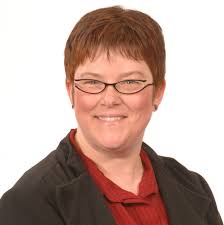 …which brings me to the present project, Sing Ducks Sing. I am partnering with Kelley Jo Burke, a playwright, (see http://kjb.squarespace.com/) who has written and performed a play that may most legitimately be called an autoethnography, entitled Ducks on the Moon (2014/2010). Kelley Jo Burke performatively memoirs supposing, understanding and accepting that her son has Autism Spectrum Disorder (ASD). It is a powerful piece; it is a powerful experience. I am/we are transforming/adding songs to this play. As noted above, I have called this endeavour Sing Ducks Sing, purposefully—just as the phantom fervently commanded Christine Daae to sing!, I feel overwhelmed and doubtful, but at the same time compelled and accountable to follow the of wonder of ABER Ducks. Stay tuned here for our progres…
…which brings me to the present project, Sing Ducks Sing. I am partnering with Kelley Jo Burke, a playwright, (see http://kjb.squarespace.com/) who has written and performed a play that may most legitimately be called an autoethnography, entitled Ducks on the Moon (2014/2010). Kelley Jo Burke performatively memoirs supposing, understanding and accepting that her son has Autism Spectrum Disorder (ASD). It is a powerful piece; it is a powerful experience. I am/we are transforming/adding songs to this play. As noted above, I have called this endeavour Sing Ducks Sing, purposefully—just as the phantom fervently commanded Christine Daae to sing!, I feel overwhelmed and doubtful, but at the same time compelled and accountable to follow the of wonder of ABER Ducks. Stay tuned here for our progres…
References
Bullough, R.V., and Pinnegar, S. (2001). Guidelines for quality in autobiographical forms of self-study research. Educational Researcher (30), 3, 13-21.
Burke, K.J. (2010). Ducks on the Moon: A Parent Meets Autism. Hagios Press: Regina, SK.
Burke, K.J. (2014). Nights with Ducks: Why I Memoir-Ted Talk (Available online at: https://www.youtube.com/watch?v=UNTKKBYHfFk)
Carless, David & Douglas, Kitrina (2011). What’s in a song? How songs contribute to the communication of social science research, British Journal of Guidance & Counselling, 39:5, 439-454.
Feldman, A. (2003). Validity and quality in self-study. Educational Researcher, 32 (3), 26-28.
Mitchell, C., O’Reilly-Scanlon, K., & Weber, S. (Eds.). (2013). Just who do we think we are? Methodologies for autobiography and self-study in education. Routledge.
Rolling Jr, J. H. (2010). A paradigm analysis of arts-based research and implications for education. Studies in Art Education, 51(2), 102-114.
Sanders, James (2006). Performing arts-based education research: An epic drama of practice, precursors problems and possibilities. Studies in Art Education, 48(1), 89-107.
Here are some pics from my first CD Faith is a Bicycle

